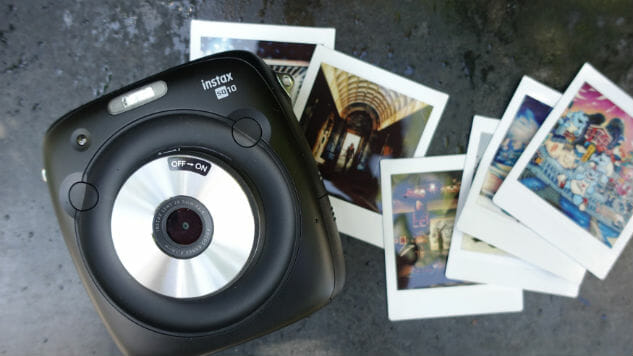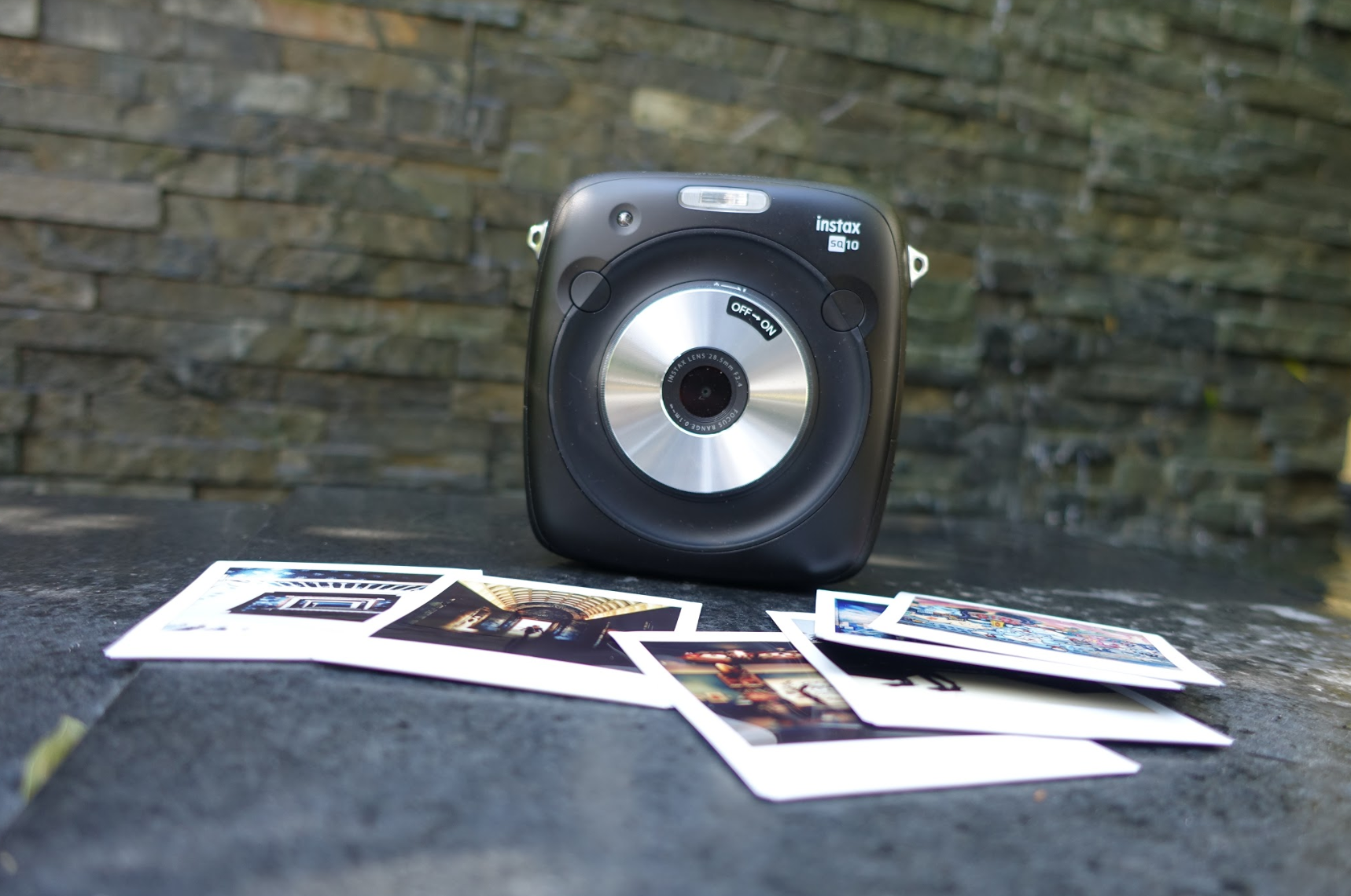
Long before Instagram’s social sharing and Snapchat’s ephemeral photos, there was Polaroid, known for its popular square format instant film that develops right before your eyes. And while this analog precursor to Instagram didn’t require an Internet connection to upload images, photographers could share their masterpieces by quickly taking a photo and instantly giving the print away. But despite the ease of sharing delivered by instant film, the drawback is that only one photo can be created. Unlike traditional film or digital photographs, there were no negatives to make reprints, so you could only get just one Polaroid.
With a renaissance and renewed love for analog, it’s no surprise that Fujifilm would tackle the beloved square instant photography format with its $279 Instax SQ-10. While the SQ-10 brings back the familiar Polaroid look, it’s also a more advanced instant film camera designed for a more tech-centric audience. It’s Fujifilm’s first camera to utilize the square aspect ratio, with previous cameras supporting either a narrow Instax Mini format or a landscape Instax Wide film.
The Instax SQ-10 also introduced another first for Fujifilm—it’s the first Instax camera to come with a digital sensor. By introducing a digital sensor, the Instax SQ-10 is a hybrid camera that artfully straddles embracing the moment while at the same time allowing photographers the flexibility to make reprints at a later time. Despite its digital versatility, the SQ-10 still delights with its instant film that develops in just over a minute.
Design

Given Fujifilm’s riff on analog social sharing and square format photography, it comes as no surprise that the Instax SQ-10’s design is a play on Instagram’s logo, which itself is a cheeky artistic interpretation of a vintage Polaroid camera.
The Instax SQ-10 comes in a single matte black color. The camera itself is housed in a bulbous square-shaped plastic body with curved edges and rounded corners. The design itself is simple—you have the lens centered on the front surrounded by a chrome wheel that can be rotated to switch on the camera. There’s a small xenon flash up top, and a red autofocus assist lamp. A recessed circle, which is coated in a soft touch material, around the chrome wheel gives you a comfortable area to rest your fingers. There are also two programmable buttons—you can set it so that both buttons act as the shutter button, making the camera ideal for right-handed or southpaw shooters—on either side. The overall design gives the camera a bear-faced silhouette from the front, with Fujifilm said that the design adds symmetry.
Circular lugs are located on each side of the SQ-10—Fujilfilm also includes some rings in the box—that can be used to attach a neck or included wrist strap. Unfortunately a neck strap doesn’t ship with the camera. I would recommend a neck strap, as the Instax SQ-10 is a sizable device with a good amount of heft that gives it a solid feel in your hands, but this makes the camera feel heavy if you’re carrying it in your hands all day when walking around. Although the camera is cloaked in a stealthy black, you can definitely customize this camera with a whimsical strap to show off your personality.
The battery door is on the bottom right side of the camera—a rechargeable battery is included—and there is also a switch that allows you to toggle between Auto and Manual modes. This toggle isn’t used for exposure control, but instead, on the Instax SQ-10, the switch is used to tell the camera whether or not you want to automatically print a picture after the image is captured or save film by setting it to manual print. This allows you to be able to review all photos before printing, and the SQ-10 acts more like a digital camera with a film printer attached.

On the left side, you’ll find a large door that hides away the microUSB port for charging and a microSD card slot. Although the camera’s built-in memory is capable of storing up to 50 images, you’ll definitely want to use a memory card if you intend on sharing the digital files to social media. Although the camera will capture the digital files to its own storage without a memory card, you won’t be able to copy images from the camera to your external storage later. If you have a card inserted, the camera will store photos onto the card by default. Up top, a long slit sits on the camera, and this is where the printed photo gets ejected from the camera.
On the back, you’ll find a non-touch display, which is useful for composing your shot, and a circular button interface along with a rotating jog dial and control wheel. The interface allows you to dive into the camera’s menus, review photos and print. The three buttons on the top are probably most useful for everyday use. They buttons allow you to add your own filters, similar to Instagram, to mimic a more vintage film look or print in monochrome, adjust how much vignetting there is around the corners and also adjust your picture brightness.
The digital screen doesn’t rotate or tilt, making selfies a bit harder to do, and there isn’t a mirror attachment accessory for this camera, as on similar Instax cameras in Fujifilm’s lineup.
The brightness control may appear like it’s a traditional exposure compensation feature, but in reality it’s just used to brighten or darken an image. You can adjust these settings—along with vignetting and filters—either at the time the photo is captured or after the image is taken.
A small switch at the top center just above the LCD screen is used to open the film door. Instax film comes in cartridges, similar to Polaroid integral prints before it, and each cartridge yields 10 prints. A cartridge costs $16, working out to $1.60 per print. Unlike other Instax formats, you’re paying a premium for the square aspect ratio and the nostalgic Polaroid feel, and Fujifilm does not sell these cartridges in multi-packs right now.
It’s an Instax Moment

Image quality is generally good, and the digital screen allows you to more accurately frame your shots. The experience is similar to using a digital mirrorless camera or DSLR. On older Instax models without a digital sensor, the digital screen isn’t present and the viewfinder isn’t always accurate for composing your shot, especially if your subject is closer to the lens.
The nice thing about the screen is that although you’ll end up capturing a square photo, the screen gives you a rectangular view, allowing you to see a little bit more on the left and right of your shot, giving the SQ-10 a rangefinder-like experience.
The digital 1/4-inch sensor, sadly, is just three megapixels. While the Instax produces good quality film prints, the digital files are small, especially if you’re looking to blow up the photos later. For sharing to Instagram, the camera’s 1,920 × 1,920-pixel resolution matches photos displayed on the social network, but I wished the camera came with a larger sensor for better digital preservation.
For comparison, Polaroid’s Snap Touch, which comes with a touchscreen and prints to a specialty Zink paper, comes with a 13-megapixel sensor. Polaroid is also working on a square format camera that will be released later this year with a 20-megapixel sensor, producing slightly larger square format photos the same size as older Polaroid prints and the modern day Impossible Project film. The big difference between the Polaroid options and the Instax SQ-10 is that Polaroid comes with a built-in digital printer where the ink is embedded into the paper, so you won’t need cartridges to print. Fujifilm’s Instax, on the other hand, uses a type of film called integral film.
Images take about a minute or so to develop with the Instax film, and it still feels like magic when photos develop before your eyes. In addition to being a fun camera to shoot with, having friends and family gather around to watch the film develop is still a delightful experience that won’t be lost on today’s Instagram generation. It’s definitely a conversation starter when you take the Instax to a party, and by having an instant artifact of the moment captured, your friends will likely be fighting over who gets to take the photo home. Fortunately, with the Instax SQ-10, you can make reprints, which is a contentious point for instant film photographers.
While purists will balk at the thought of being able to make reprints on instant film, the feature comes in handy for analog social sharing. Additionally, the camera’s shutter is a bit slow, especially in low light, so may end end up with blurry shots. By being able to review photos and choosing what you want to print, this also helps to save money and reduce wasted film.
Personally, I don’t think that going digital takes away from the instant photography experience. All my friends seem to be cognizant that a print is being made, which costs money, and they’re more inclined to pose for the camera. With digital, you can snap a burst of photos and choose the best shot, so photo moments feel more dispensable. And as a photographer, I was also more aware of what I choose to photograph. Whereas I would snap at about anything and everything with my phone’s digital sensor—digital is cheap—I was more picky with the Instax, taking the time to compose my shot to ensure everything is the way I want it before I press the shutter button, even though I know I didn’t have to print everything I shot.
It’s a Photo Finish

Despite the small image resolution, images are good, and I was surprised by how detailed the photos. Even in high contrast situations, the fill-flash does a nice job to keep details in the highlights while brightening up the rest of the shot. That said, there were some quirks with the Instax SQ-10.
There is a discrepancy between what you see on your screen and the resulting instant film image produced by the camera. On screen, photos appear bright, and sometimes this means overexposed highlights that are blown out. However, when printed, images seem to be underexposed with a darker tone. Fortunately, though, you can make image adjustments to brighten or darken your shots and reprint your photos to suit your needs, thanks to the digital technology on this Instax.
Compared to a non-digital Instax, like the Instax Mini 9, composing images with the screen is more accurate and prints appear sharper. However, compared to the photos captured on a phone and printed with Fujifilm’s Instax SP-2 Share Printer, the images from the SP-2 were sharper and came out like they were printed on regular photo paper. Exposure was spot on with the SP-2 and those prints didn’t suffer from the same exposure discrepancies on the SQ-10. The sharpness of the photos from the SP-2 gave it more of a print quality, whereas the quirky quality of the Instax SQ-10 gave it an old-school Polaroid feel—it wasn’t always the sharpest photo, but there was an endearing quality that makes it special. The SQ-10 trades in perfection for nostalgia and emotion.



Compared to Impossible Project’s film designed for vintage Polaroid cameras, the Instax film delivers more consistent results. Both instant film use the square format, but the Instax prints are a bit smaller. Impossible Project’s film has its own quirks making it frustrating for casual shooters. Impossible Project also requires more effort—you need to shield the film from light just as it comes out of the camera, which defeats the fun of watching the film develop before your eyes. Additionally, Impossible Project film can require thirty minutes to develop. These quirks aren’t part of the Instax experience
When you’re editing images on the SQ-10, adjustments to the images are nondestructive. These adjustments aren’t saved over the original file. Instead, the camera records the changes you make to an accompanying XLS file to accompany the photo. If you’re looking to share the digital file, unfortunately, this means that the adjustments won’t be saved and you’ll have to re-edit the photos again on your phone or PC. Additionally, you can also print images captured from your digital camera or smartphone using the SQ-10 by transferring those shots to a microSD card. The SQ-10 would automatically crop non-square photos, so it’s recommended that you pre-crop and make your image adjustments before copying the files over.
Unlike many modern cameras, the Instax SQ-10 doesn’t come with Bluetooth or Wi-Fi, which makes it harder to share photos captured with the Instax to social media right away — you’ll need to swap out the memory card each time you want to share. I didn’t find this to be a downside at all—this kept me purely in the moment without having to worry about uploading, sharing or counting “likes” on social networks. And if there was something truly worthwhile for sharing, I know I can go home and do that later, so it wasn’t a dealbreaker.
What Fujifilm should have done is released an app, similar to what Impossible Project did, allowing you to use your phone’s camera to scan in your Instax prints—complete with the nostalgic white borders—to share on Instagram. While you can share the SQ-10’s digital files directly on Instagram, a scanning app makes digital sharing more immediate—you don’t need to fumble around with swapping out memory cards—and the resulting scan with the white borders adds another element to the instant film story.
Verdict

If you’re looking for an easy to use camera to recreate the Polaroid look of yore, Fujifilm has created the perfect balance of retro-chic nostalgia with modern tech infusion. The square format is instantly recognizable, and even without applying digital gimmicks like filters, film offers its own quirks and character that a digital camera cannot recreate.
The SQ-10 is fun to shoot with, and the instant prints are sure to be conversation starters at a party. Additionally, shooting with instant film—even if it’s in a digital camera—also forces you to be more focused with your photography, forcing you to slow down to pose or compose the perfect shot for a moment frozen in time. Advanced users will also appreciate more artistic controls with instant film. The Instax SQ-10 comes with a bulb mode for light painting and you can also do double exposure for cool effects on film.
At $279 for the camera and $16 per pack of 10 films, the square experience isn’t cheap. Fujifilm’s Neo Classic 90, for example, can be found for as low as $115 and multi-packs of that camera’s Instax Mini film format costs just $0.58 per shot, less than half the price of a Fujifilm’s square format print. With the SQ-10, you’re paying a premium for the square aspect ratio as well as the digital capability to save and reprint the instant moment. If you’re willing to make the investment, the SQ-10 is a fun camera to shoot, and the instant prints will delight those around you. For young Instagrammers who never grew up with Polaroid, it introduces a new generation to the magic of film.